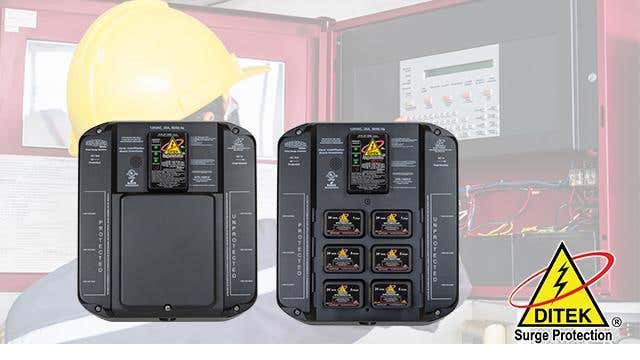Integrating Surge Protection into Fire Alarm Systems is Key
Over the past four decades, fire alarms and life safety systems have become an essential element of manufacturing, industrial and commercial structures and the improved safety statistics bear out the importance of a functioning fire/life safety system for the protection of people, property and assets. The NFPA mandates proper code and compliance standards for all facilities to ensure occupancy and safe operations.
A technically sound and working fire alarm system mitigates numerous risks to an organization including saving lives, reducing property loss, keeping an organization code-complaint, and possibly qualifying an organization for insurance discounts. In fact, some insurance providers require you to install a fire alarm before they will insure your facility.
Protecting the Heart of the System
As with any crucial building system, the challenge of maintaining constant and uninterrupted power for a fire/life safety system can be problematic considering the barrage of surges and spikes that often migrate from external sources, and the threat of similar interruptions from within the facility. The increased use of more sensitive electronic circuitry puts fire alarm systems at more risk of transient damage and can lead to costly and dangerous malfunctions. This is a motivating factor for system designers when they insist on including surge protection on AC power lines and data communication lines which are directly wired to fire alarm systems. According to the National Burglar and Fire Alarm Association (NBFFA) and other industry analysts. Nearly 30% to 40% of all damaging transients enter a system via the AC circuit, but an even greater number come in by way of low voltage circuits .
Fire alarm control panels (FACP) are the intelligence center of any fire system, monitoring all safety information from smoke detectors, heat detectors, and manual fire alarm stations. Because of this, the integrity of the panel must be protected from dirty power, surges and spikes if it is to do its job of triggering output devices such as bells, horns, and strobes. Since the FACP sits at the heart of the fire alarm and life safety system, its 120V power source should be equipped with a surge protection device. By installing surge protection on any copper wire circuit entering or leaving a fire panel, you protect the system from the potentially damaging effects of lightning strikes and internally-generated surges.
One of the responsibilities of surge protectors is to absorb a sudden rush of electrical power – even if it causes them to be severely damaged or go end-of-life. When this occurs, all surge protection devices must be inspected to verify they are functional. Some surge protection devices are equipped with visual indicators for this purpose. But it is a best practice to check all devices to determine if they need to be repaired and/or replaced by a qualified technician.
While fire alarm installation is the first step in protecting life and property, it does not nullify the importance of ongoing fire alarm inspections and testing. Once a fire alarm system is installed or replaced, it is required to be inspected annually per the NFPA. The specific standard for fire alarm systems is NFPA 72. NFPA requires that simple weekly and quarterly visual checks, more thorough semi-annual tests, and professional annual inspections be performed by a licensed fire protection company. These tests ensure that the panel and all the ancillary devices are operating in accordance with the manufacturer and NFPA.
Any failure to correctly design and inspect your organization’s fire/life safety systems and ensure that proper surge protection devices are in place could result in costly and catastrophic issues. An undetected malfunction in a fire panel could disrupt the information delivery process and delay firefighting efforts, or it might result in false alarms that could disrupt your daily operations and needlessly dispatch fire trucks to your location, possibly resulting in fees for repeat offenses. You might also be fined for failure to comply with fire safety codes and your insurance carrier would likely reject any claim filed if your inspections are not current.
Putting Your Fire Protection All in One Box
Having an efficient and cost-effective surge protection device as part of the total fire/life safety system design is mission critical. Advanced power protection devices feature modular designs with LED and audible status indicators that allow individual surge modules to be easily identified and quickly replaced, and include dry contacts to facilitate remote notification of surge protection status.
DITEK recently released a new surge protection solution for fire alarm systems that combines protection for 120V system power with protection for up to 12 low voltage circuits to eliminate unnecessary damage caused by electrical surge events. The DTK-120X12 model offers a unique and compact new combination that simplifies implementation of comprehensive surge protection for critically important fire alarm systems while providing for remote monitoring of surge protection status using dry contacts. The convenient plug-in design simplifies installation of low voltage surge modules and allows for easy replacement when needed. The combination of complete system protection along with high quality construction and field-replaceable modules makes this new offering a perfect fit for protecting alarm systems and control panels.
Most fire safety systems experts recommend that the end-user or systems integrator do their homework and consult with reputable surge suppression solutions providers to see what device best fits the system and the facility’s needs.


